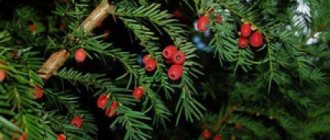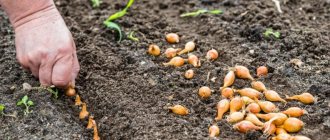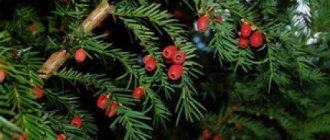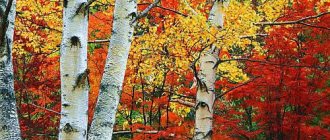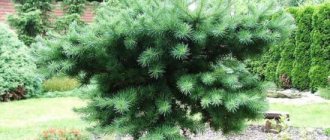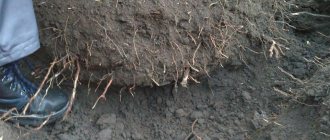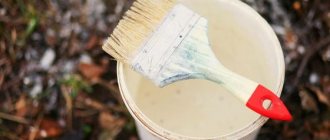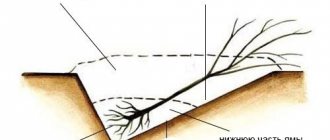For the purpose of designing a personal plot, various plants are used. Fast-growing trees allow you to get quick results in a short period of time. With their help, a garden or dacha will be landscaped in a relatively short time. Such crops are characterized by intensive development. Over the course of a year, they can grow from 0.5 m to 2.0 m. You may not have to wait for results for many years; to do this, you need to know all the features that these plants have, take into account their power and growth rate.
Classification of fast-growing trees
When selecting plants, special attention should be paid to such characteristics as length and width. The growth criterion is determined by the rate of growth of young shoots and the size of the trunk during the year. According to these values, fast-growing trees are classified according to the rate of annual growth:
- Up to 25 cm. This is a category of very slowly growing trees. These include common juniper, evergreen boxwood, and dwarf forms of larch.
- From 25 to 50 cm. Forest apple, Ussuri pear, sea buckthorn, cedar and magnolia are prominent representatives of slow-growing plants.
- From 50 to 100 cm. Quince, Siberian fir, common linden, western thuja, maple, and lilac grow moderately in nature.
- Up to 200 cm. Fast-growing crops include pine, bird cherry, walnut, and common viburnum.
- About 200 cm. Trees of super-intensive development are pyramidal poplar, aspen, birch, white acacia, and willow.
Fast-growing breeds surprise with their diversity. With the help of landscape design you can make a plot of land original and unique.
Selecting Fast-Growing Breeds
It is better to purchase seedlings in nurseries, at fairs or specialized exhibitions. They will always tell you which plants are growing rapidly and how to care for them. When choosing the tree you like, you should pay attention to the following factors:
- Magnitude _ To determine the area for planting, you need to know the diameter of the crop’s trunk in adulthood. Freedom is needed for full development.
- Growth . Knowing how quickly a tree will grow will allow you to imagine its maximum size in the future.
- Crown shape . This indicator is important both from a practical and decorative point of view. The choice of crown depends on the style of landscape design provided for by the project.
- Land area . Having studied the previous three factors, you can accurately calculate the optimal number of trees that can be planted on a plot of land.
- Soil composition. If the soil composition is not suitable or groundwater is close to the surface, this will lead to the death of the crop.
- Climate. This is important for the middle zone, where frosty weather arrives early. To prevent plants from freezing, it is necessary to choose winter-hardy ones.
It is important to decide for what purpose the crops are acquired. Ornamental shrubs and species such as lilac, hawthorn, and willow are perfect for living fencing. They grow rapidly and tolerate constant pruning well.
Provided that fast-growing trees are selected correctly, any cottage or garden plot can be beautifully landscaped in the shortest possible time.
Fast growing shrubs
To create a harmonious landscape composition, it is better to separate tree plantings with shrubs. Among the shrubs there are also varieties with very active growth. Often shrubs are planted along fences, forming a hedge. You can create picturesque bush fences in just 1-2 seasons.
Types of shrubs with rapid vegetative growth:
- Barberry. This thorny shrub grows well in northern latitudes and is frost-resistant. The height of the bushes is on average 2 m. The leaves and shoots are green and purple. Produces sweet small fruits used for jam, compotes, and medicinal tinctures.
- Bladderwort. Planted along paths and fences. An unpretentious, fast-growing and densely growing shrub. It grows in height by 40 cm per year. Requires regular pruning. With uncontrolled growth it reaches 4 m in height and width.
- Snowberry. The honeysuckle family shrub grows successfully on all types of soils and is common in southern, temperate and northern latitudes. Tolerates drought and severe frosts. The height of the bushes reaches one and a half meters. It blooms throughout the summer, and in late autumn is covered with inedible white berries.
- Lilac. A popular shrub with an annual growth of 20 cm for low varieties and 40 cm for high varieties. The height of adult plants is 1.5−3 m. For faster development, lilacs need spring pruning. Varieties differ in shades of flowers and doubleness. All varieties, without exception, smell pleasant and quite intense.
- Hawthorn. The hawthorn bush meets all the requirements of landscape design. It can grow as a dense and impenetrable wall due to strong branching and an abundance of long thorns. Hawthorn does not grow very quickly at first, but after 3-4 years the growth rate reaches 60 cm per year. Not only hawthorn fruits are valuable, but also leaves, flowers and roots, which are used as raw materials for the production of medicines.
It is better to purchase seedlings from a trusted nursery or at specialized exhibitions. Experienced sellers and gardeners will always tell you which trees grow quickly.
Fruit trees
A personal plot implies the presence of fruit crops, the main task of which is to delight every spring with beautiful flowers and aroma, and in the summer or autumn with a fruit harvest. The following types are popular:
| Name | Annual growth, m | Maximum height, m | diameter , cm | Average life expectancy, years |
| Apricot | 1-1,5 | up to 12 | 30–60 | 30–40 |
| Plum | up to 2 | up to 15 | 40 | 15–60 |
| Cherries | up to 1 | 10–15 | 60 | 25–30 |
| Walnut | 1,5 | 15–30 | 200 | 400–600 |
There are differences in planting and caring for fruit crops. You should clearly know which breeds produce high yields, adapt well, bear fruit regularly, are resistant to diseases and pests, have excellent taste and beautiful appearance in this area.
When selecting plants for the garden:
- It is necessary to inquire about the resistance of crops to adverse weather conditions.
- Take into account the relationship of fruit crops to soil, humidity, and light.
Therefore, special varieties have been bred for each region.
It is important to choose the right planting material to ensure the survival of fruit trees and to obtain a high yield in a short time.
Trees as screens
Use them to block second-floor neighbors' views of your yard or to block north winds. Plant them in rows, groups or alone, depending on their distribution.
Metasequoia glyptostroboides
A huge pyramid-shaped tree with fluffy green needles that turn reddish-brown-orange in the fall. Strikingly deeply grooved bark. It will grow 21-30 meters high by 7.5 meters wide; Thrives in moist, well-drained, slightly acidic soil and full sun.
European black alder
This is an oval deciduous tree, useful as a screen in a wet area or pond. Grows up to 12-18 meters in height and 6-12 meters in width; Thrives in full sun or partial shade in moist soil where other trees may die.
Eastern white pine
Evergreen blue-green needles. Has a pyramidal shape when young. Grows up to 15-25 meters in height and 6-12 meters in width; Thrives in moist, rich, well-drained, acidic soils and full sun. Does not tolerate windy places.
Thuja "Green Giant" arborvitae
An evergreen tree with a uniform pyramidal shape, grows from 90 cm or more per year. Used as fencing elements. Grows up to 6-9 meters in height and 3-6 meters in width; adaptable but prefers moist, well-drained soil and full sun.
Deciduous crops
In a short time, you can green up a recreation area on your personal plot by planting fast-growing deciduous trees. Now these are the main landscapers of the whole country. The leaves and flowers of some of them secrete phytoncides that disinfect the air. In just 2–3 years they will provide dense greenery and abundant shade. Most Popular:
| Name | Annual growth, m | Maximum height, m | diameter , cm | Average life expectancy, years |
| Birch | up to 2 | up to 45 | 50–70 | 300 |
| White acacia | up to 1.5 | until 25–30 | 30–40 | up to 50 |
| Willow | 0,5-1,0 | 15–40 | up to 100 | 20–150 |
| Maple | up to 2 | 30 | up to 100 | 200 |
| Poplar | more than 2 | 40 | up to 300 | up to 400 |
Deciduous crops adapt well to changing weather conditions. Some beneficial substances of these trees are used in medicine. It is better to plant seedlings in the fall. At the initial stage of growth, they need frequent and abundant watering. After successful rooting, they produce strong shoots next year.
The idea of “your own forest” with deciduous trees several tens of meters long is unlikely to occur to a person with a traditional six hundred square meters.
Deciduous trees are a real plus: they don’t cause trouble; beautiful; protect from piercing winds; retain snow in winter; create shade in hot weather.
Conifers
Over the past few years, it has been popular to decorate garden plots with fast-growing coniferous trees. Thanks to their coniferous leaves and trunk shape, they are used in creating landscape compositions. Plants are unpretentious, therefore they have a number of advantages:
- Fir. These trees rank first in beauty among conifers and are a favorite shelter for animals in the taiga. They grow rapidly and tolerate the absence of light and heat well. The plant has a straight trunk with a pyramidal crown. Among other conifers, fir is recognized by its cones sitting vertically on its branches. In nature, some trees reach 80 m in height. Therefore, decorative views will bring aesthetic pleasure to your dacha.
- Cedar. One of the most ancient plants, which is a symbol of power. It usually lives up to 250 years and grows up to 50 m in height. The trunk of mature trees reaches 2 m in diameter. Siberian and European cedar are suitable for home planting. How long a tree grows depends on the lighting conditions.
- Larch. This is a powerful tree up to 40 m in height. In autumn the plant turns bright orange and yellow, and before winter it loses its needles. Lives more than 500 years. Larch can withstand very low temperatures and can grow even in permafrost. In home gardens, trees are represented by miniature varieties.
- Thuja. It is represented by evergreen coniferous trees. This plant lives for more than 150 years. In natural conditions, the height of the thuja can reach 70 m, and the trunk diameter up to 6 m. In garden culture, the thuja grows up to 11 m. It is an unpretentious, winter-hardy breed with original leaves. The shape of the thuja is spherical or columnar.
Gardeners love coniferous trees because they grow well in limited sunlight, can survive for long periods without watering, and grow on rocky soils.
Which fast-growing trees and shrubs are best to plant in a dacha - review with photos
When choosing the type of vegetation for planting, summer residents mainly focus on two factors - practical benefits (for those that will bear fruit) and appearance (intended for the decorative design of their summer cottage).
But what to do if it is not inhabited at all, and everything has to start literally from scratch? The optimal solution is to plant fast-growing shrubs and trees. How are they characterized? Mainly by the intensity of development. Such trees include those that annually grow by about 0.5 m or more (up to 2 m); for shrubs - from 0.3 m. Their number on the site is determined by the feasibility of planting, its size and layout, since each owner has his own preferences in matters of cultivation, canning, and so on. But this is a matter of taste.
But what can you plant in your dacha right away, regardless of your future plans? Let's figure this out. There are quite a lot of options, as well as opinions, so we will focus on the most common fast-growing plants, but not the only ones possible for planting at a dacha in the middle zone of the country.
Lilac
There are many varieties of this shrub. But regardless of the choice of variety, it will decorate any site.
Willow
It develops very intensively (it is considered a record holder in this regard), and is also unpretentious. And if there is an artificial reservoir on the site - a pond or a fountain with a pool - then willow is perfect. By the way, if the territory needs to be fenced with a “live” hedge, then this plant will come in handy here too.
Single color fir
Not to mention the fact that it creates a special microclimate on the site (after all, it is a coniferous species), fir is interesting from another point of view. It stretches 25 - 35 m in height, while it has a crown of up to 9 m (in diameter). If the area is not blocked by any other plantings (buildings) and is constantly exposed to sunlight, then such a tree will reliably shade it. The main thing is to choose the right place for planting, taking into account all the features of the dacha.
Barberry
This plant is so unpretentious that it takes root well in any soil. The only thing it doesn’t like is waterlogging. You can make a reliable “living” hedge from barberry. Through its thorns, let alone a person, a hare will not penetrate into the area.
It is clear that such a small list is not able to fully satisfy the interest of summer residents in fast-growing shrubs and trees. Therefore, we will limit ourselves to listing the possible options.
- Birch, poplar - they develop quite quickly (up to 1 m of growth annually).
- Hazel.
- Hawthorn.
- Kalina.
- All varieties of juniper.
- Bird cherry.
- Coniferous trees.
- White acacia is one of the record holders for growth. But it is considered a “sissy”, so it is necessary to select one that develops well in a given region (adapted to local conditions).
- Spirea.
- Thuja.
- Yew.
- Rose hip.
- Tamaris.
- Elder.
- Honeysuckle.
What to consider
- Any plant must adapt to the characteristics of a new place. Therefore, you can wait for the development of even a fast-growing shrub or tree to begin only in the next season.
- Soil composition and moisture content. For the normal development of a seedling, certain conditions are necessary that are suitable specifically for it. Only then can we count on its rapid development.
- Sometimes gardeners intensively plant an area with raspberries. You need to keep in mind that it grows quite quickly. Moreover, its shoots literally “spread” across the territory. This fruit shrub requires quite a lot of time and effort to care for.
How to decorate your garden plot
It is important for the owner who owns the land that his territory always remains picturesque and attractive. Fast-growing trees can perform this function perfectly.
Special attention is paid to fruit crops in landscape design. There are specific planting patterns that depend on the style and size of the area. Their advantage is fertility, and therefore usefulness. Once the crops have been selected, planning of the functional composition begins. You can plant an alley of fruit trees or a hedge. In small areas it is more correct to adhere to the landscape style.
When choosing deciduous crops for decoration, we must remember that by winter almost all of them lose their appearance. The impression of them is created by the color and shape of the foliage, and the aroma of the flowers. Their appearance during the season is important. When choosing deciduous trees, take into account their adult size and requirements for climatic conditions. A wall is formed from tall trees, and the foreground of the composition from low-growing trees.
The unusual shape of the crown and leaves of conifers gives the place a southern flavor. Due to their monumentality, they form the basis of the entire composition. Particular importance is given to the color and texture of the needles. To make the composition look harmonious, a well-groomed lawn is left as a background. Trees should be oriented to the west or east, and contrast in their sizes and shapes will help achieve visual effects.
Principles of landscaping
A harmoniously built landscape structure is one of the most important conditions for improving territories. In landscape design, several principles are used that take into account the properties of the site and the individual elements introduced into it. Knowing which trees grow quickly and which plants bloom lushly and abundantly, you can create separate zones that will perfectly complement and highlight each other.
When landscaping you should consider:
- plot size,
- plant growth rate,
- the size of adult plants,
- height of groundwater,
- soil quality,
- resistance of seedlings to frost and drought,
- combination of plants,
- smooth transitions of individual tiers.
When planning your landscape, you need to be patient. The growth and development of green spaces takes time and changing seasons. However, well-chosen fast-growing trees and shrubs will allow you to beautifully landscape any area in the shortest possible time.
